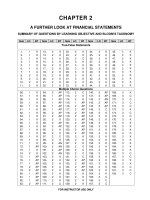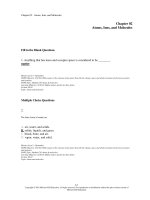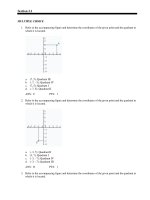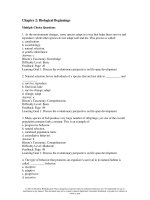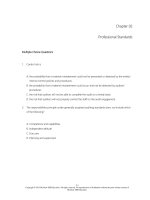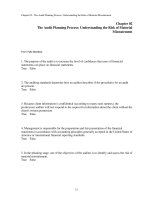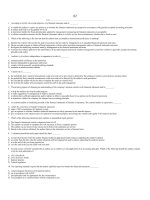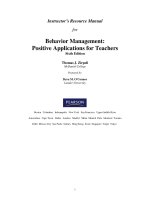Criminology today an integrative introduction 6th edition schmalleger test bank
Bạn đang xem bản rút gọn của tài liệu. Xem và tải ngay bản đầy đủ của tài liệu tại đây (745.33 KB, 59 trang )
Online Instructor’s Manual and Test Bank
to accompany
Criminology Today:
An Integrative Introduction
Sixth Edition
Frank Schmalleger
Upper Saddle River, New Jersey
Columbus, Ohio
__________________________________________________________________________________
Copyright © 2012 by Pearson Education, Inc., Upper Saddle River, New Jersey 07458.
Pearson Prentice Hall. All rights reserved. Printed in the United States of America. This
publication is protected by Copyright and permission should be obtained from the publisher prior
to any prohibited reproduction, storage in a retrieval system, or transmission in any form or by
any means, electronic, mechanical, photocopying, recording, or likewise. For information
regarding permission(s), write to: Rights and Permissions Department.
Pearson Prentice Hall™ is a trademark of Pearson Education, Inc.
Pearson® is a registered trademark of Pearson plc
Prentice Hall® is a registered trademark of Pearson Education, Inc.
Instructors of classes using Schmalleger, Criminology Today: An Integrative Introduction, 6th
edition, may reproduce material from the instructor’s manual for classroom use.
10 9 8 7 6 5 4 3 2 1
ISBN-13: 978-0-13-707457-0
ISBN-10:
0-13-707457-3
Table of Contents
Introduction……………………………………………………………………………….. 4
PART ONE: The Crime Picture
Chapter 1 - What is Criminology?......................................................................................... 6
Chapter 2 - Where Do Theories Come From?....................................................................... 20
PART TWO: Crime Causation
Chapter 3 - Classical and Neoclassical Thought……………………………………………38
Chapter 4 - Biological Roots of Criminal Behavior……………………………………….. 60
Chapter 5 - Psychological and Psychiatric Foundations of Criminal Behavior…………….80
PART THREE: Crime Causation Revisited
Chapter 6 - Social Structure Theories……………………………………………………… 100
Chapter 7 - Theories of Social Process and Social Development………………………….. 117
Chapter 8 - Social Conflict Theories………………………………………………………. 141
PART FOUR: Crime in the Modern World
Chapter 9 - Crimes against Persons………………………………………………………... 158
Chapter 10 - Crimes against Property……………………………………………………… 187
Chapter 11 - White-Collar and Organized Crime………………………………………….. 204
Chapter 12 - Public Order and Drug Crimes………………………………………………. 223
Chapter 13 - Technology and Crime……………………………………………………….. 244
Chapter 14 - Globalization and Terrorism…………………………………………………. 261
EPILOGUE: Future Directions………………………………………………………….. 274
Video Library Notes……………………………………………………………………….. 284
Test Bank……………………………………………………………………………………303
Test Bank Answer Key…………………………………………………………………….. 790
Introduction
This instructor’s manual is designed to accompany and to complement the textbook. It provides the
instructor with a comprehensive overview and summary of the textbook to make teaching easier and more
effective.
The chapters of this manual directly correspond to those in the textbook. Each chapter contains the
following information:
1. Learning Outcomes: This section outlines the learning objectives for the chapter, as listed in
the textbook at the start of the chapter.
2. Chapter Outline: The chapter outline lists the major (first and second level) headings in the
chapter.
3. Chapter Summary: The chapter summary is one to three pages in length and highlights the
key points in the chapter.
4. Lecture Outline: This is a detailed outline of the material provided in the chapter and is
intended to be used as a lecture guide. Each outline includes suggestions regarding the use of
relevant material from the Prentice Hall Video Library (ISBN 0135134978).
5. Key Terms: This section includes a list of the key terms for the chapter as well as the glossary
definition for each term.
6. Additional Lecture Topics: This section contains ideas for topics that are not contained in the
textbook but which closely complement the material in each chapter. They may be used to
expand upon the chapter and provide additional lecture material.
7. Questions for Review: A list of questions for review is provided at the end of each chapter in
the textbook. Short answers to each question are provided in this manual. Instructors may want
to focus on these questions after lecturing on the appropriate chapter or may use them as essay
questions.
8. Questions for Reflection: A list of questions for reflection is provided at the end of each
chapter in the textbook. Unlike the questions for review, which are more factual, these questions
are designed to encourage critical thinking among students.
9. Student Exercises: This section includes several exercises or activities that may be assigned
to students. Some involve in-class group discussions, although many of these could also be
conducted outside of class. Others involve take-home work and may be assigned for homework
or extra credit. These exercises involve a wide variety of tasks, including searching the Internet,
interviewing criminal justice system personnel, and examining crime-related data. Some of the
assignments involve researching the criminal justice system of a city or state. The instructor may
consider assigning each student a different area to research and then comparing their findings in
class.
10. Criminology Today on the Web: This section includes a list of sites on the World Wide
Web that are related to the information in the chapter. They may include links to criminal justice
agencies, discussions of key criminological theories, or online articles on relevant topics.
Another section of this manual includes information on the videos in the Prentice Hall Video
Library (ISBN 0135134978) that may be used as an accompaniment to this course. For each
video, the following information is provided:
• Suggested use
• A brief summary of the video
• Notes to the instructor with additional information about the material discussed on the
video
• Discussion questions relating to the content of the video; these may also be used as
essay questions
A test bank and answer key are also provided in this manual. The test bank includes true/false,
fill-in-the-blank, and multiple choice questions. This test bank is also available on the MyTest
website at www.pearsonmytest.com, where you can create your own tests for classroom use.
1
What Is Criminology?
Learning Outcomes
After reading this chapter, students should be able to answer the following questions:
What is crime? What is the definition of crime that the author of this textbook has
chosen to use?
What is deviance? How are crime and deviance similar? How do they differ?
Who decides what should be criminal? How are such decisions made?
What is criminology? What do criminologists do?
How is social policy in the area of crime control determined? What role does
criminological research play in the establishment of such policy?
What is the theme of this book? Upon what two contrasting viewpoints does it build?
What does it mean to say that “criminal activity is diversely created and variously
interpreted”?
What discipline has contributed the most to theoretical understandings of crime causation
over the past century?
Chapter Outline
Introduction
What Is Crime?
Crime and Deviance
What Should Be Criminal?
What Do Criminologists Do?
What Is Criminology?
Definition of Terms
Theoretical Criminology
Criminology and Social Policy
Formulation of Social Policy
Social Policy and Public Crime Concerns
The Theme of This Book
The Social Context of Crime
Making Sense of Crime: The Causes and Consequences of the Criminal Event
Crime and the Offender
Crime and the Criminal Justice System
Crime and the Victim
Crime and Society
The Primacy of Sociology?
Chapter Summary
Chapter 1 provides an introduction to the textbook and to the field of criminology. Crime can be
defined in a variety of ways; the four main definitional perspectives see crime from the legalistic,
political, sociological, and psychological viewpoints. The definition used in the text is from the
legalistic perspective, which sees crime as “human conduct in violation of the criminal laws of a
state, the federal government, or a local jurisdiction that has the power to make such laws.” This
approach does have some limitations, however, some of which may be addressed by the other
perspectives on crime.
While many crimes are forms of deviant behavior, or human activity that violates social
norms, not all crimes are deviant and not all deviant behavior is criminal. There is also a
significant difference between what is criminal and what should be criminal. The consensus
perspective holds that a law should be enacted to criminalize a certain behavior when the
members of a society generally agree that such a law is necessary. However, in a multicultural
society, consensus may be difficult to achieve. The diversity of society is recognized in the
pluralistic perspective which suggests that behaviors are typically criminalized through a
political process after debate over the appropriate course of action.
A criminologist is “one who studies crime, criminals, and criminal behavior;” the term
applies primarily to academics, researchers, and policy analysts with advanced degrees who are
involved in the study of crime and crime trends and in the analysis of societal reactions to crime.
A criminalist is “a specialist in the collection and examination of the physical evidence of
crime,” while a criminal justice professional do the daily work of the criminal justice system.
There are many professional opportunities for individuals with degrees in criminology are
explored.
The field of criminology itself is also discussed in detail, with various definitions considered.
While criminology is primarily a social science, it is interdisciplinary. It contributes to, and
overlaps, the field of criminal justice. One subfield is theoretical criminology, which posits
explanations for criminal behavior. General theories attempt to explain all (or most) forms of
criminal conduct through a single overarching approach. An integrated theory does not
necessarily attempt to explain all criminality but merges concepts drawn from different sources.
General and integrated theories of crime are compared.
The development of social polices based on research findings may be of broader importance
to society than theory testing. For example, despite widespread concern among professional
groups about the effect of the media on teenage violence, policymakers have been reluctant to
curtail the production of violent media. Essentially, there is a conflict between crime reduction
policies and the profit motives of media vendors. Concern over crime is one of the key issues in
the country, making it an important determinant of public policy.
The social policy theme of the text is presented through a contrast of the two main
perspectives popular in today’s society: the social problems perspective and the social
responsibility perspective. Recently, the social responsibility perspective has had a substantial
influence on national crime control policy.
Crime does not occur in a vacuum; every crime has a unique set of causes, consequences and
participants. Crime is seen as a social event rather than as an isolated individual activity. The
criminal event is the result of the coming together of inputs provided by the offender, the
criminal justice system, the victim, and the general public (society). Background and foreground
features or inputs provided by each contributor are discussed. In addition, each crime has
consequences, or outputs, which affect not only the victim and offender but also society and the
criminal justice system. These consequences may be immediate or more long-term.
This text recognizes the primacy of sociology: the belief that the primary perspective
from which many contemporary criminologists operate is a sociological one. However, not all
criminologists agree with this perspective and new and emerging perspectives are being
developed.
Lecture Outline
I. Introduction
A. Discuss the popularity of prime time television crime shows, such as NCIS and CSI:
Miami, and the public’s interest in reality TV crime shows
B. Mention the proliferation of video magazine shows focusing on justice issues, crimerelated TV movies, and other media content reflecting public fascination with crime
II. What Is Crime?
A. Explain that various definitional perspectives exist when one attempts to define crime
1. There are four perspectives: legal, political, sociological, and psychological
2. Perspective is important because it determines what assumptions are made about how
crime should be studied
B. The legalistic perspective
1. Crime is defined as “human conduct in violation of the criminal laws of a state, the
federal government, or a local jurisdiction that has the power to make such laws”
a. This is the definition and the perspective used in this text
b. Under this definition, immoral forms of behavior that are not contravened by state
statute are not recognized as crimes
2. Limitations of the legalistic approach to crime
a. Powerful individuals may use their power to ensure that their immoral behaviors are
not criminalized
b. It insists that the nature of crime and the nature of law cannot be separated
c. Fails to recognize that formalized criminal laws did not always exist
3. Laws are constantly changing, creating new crimes or legalizing behaviors (e.g., samesex marriages, biomedical research)
C. The remaining three perspectives
1. The political perspective sees crime as behavior that in some way threatens the interests
of those with political power
2. The sociological perspective considers crime to be an antisocial act of such a nature
that its repression is necessary or is supposed to be necessary to the preservation of the
existing system of society
3. The psychological perspective sees crime as maladaptive behavior that prevents
persons from living within the existing social framework
D. Summary
1. It is difficult to come up with one simple definition of crime that is acceptable to
everyone
2. Consider the four perspectives as points on a continuum, with strict legalistic
definitions at one end and more fluid behavioral and moralistic definitions at the other
III. Crime and Deviance
A. Deviant behavior is defined as “human activity that violates social norms”
B. Discuss the relationship between crime and deviance
1. Deviance and crime overlap but are not identical
a. Not all deviant behavior is criminal
b. Not all criminal behavior is deviant
2. Discuss examples of deviant but noncriminal behavior (e.g., unusual dress styles)
3. Discuss examples of criminal but common (and often socially acceptable) behavior
(e.g., speeding)
IV. What Should Be Criminal?
A. There are distinct differences between the questions “What is crime?” and “What should
be criminal?”
B. Two contrasting perspectives are used to answer the question “What should be criminal?”
1. The consensus perspective emphasizes agreement among members of society as to
what behaviors should be considered criminal and suggests that laws should be made to
criminalize behaviors when members of society agree that the laws are necessary
2. The pluralistic perspective suggests that societies are diverse and behaviors become
criminalized through a political process involving considerable debate as to the
appropriate course of action
V. What Do Criminologists Do?
A. Criminologists vs. criminalists
1. A criminologist is defined as “one who studies crime, criminals, and criminal behavior”
2. A criminalist is “a specialist in the collection and examination of the physical evidence
of crime”
3. Criminal justice professionals include police and correctional officers, probation and
parole officers, judges, defense attorneys and prosecutors, and others who do the dayto-day work of the criminal justice system
B. Characteristics of academic and research criminologists
1. They generally have a Ph.D. in criminology or criminal justice (or a related field) from
an accredited university
2. They generally teach in universities and in two- and four-year colleges
3. They generally conduct research designed to advance criminological knowledge
4. They generally write for publication in journals published in the United States and
abroad
C. Other options for people with degrees in criminology and/or criminal justice include
work in police agencies, probation and parole agencies, court-support activities,
correctional work, government agencies, private security, civil organizations, and so on
VI. What Is Criminology?
A. Discuss the definition of criminology
1. Review the wide variety of definitions presented in the text
2. The text concludes that criminology may be defined as “an interdisciplinary profession
built around the scientific study of crime and criminal behavior, including their
manifestations, causes, legal aspects, and control”
3. Important key terms; criminology, criminality, crime, deviance, and criminal behavior
4. Criminology is mainly a social science but is an interdisciplinary field, drawing on
other disciplines, such as anthropology, biology, sociology, political science,
psychology, psychiatry, economics, theology, medicine, law, philosophy, and ethics
B. Criminology also contributes to the field of criminal justice
1. Criminal justice focuses on the application of the criminal law and the study of the
components of the justice system, especially the police, courts and corrections
2. Essentially, criminology focuses on the causes of criminality whereas criminal justice
focuses on the control of crime
C. Theoretical criminology
1. Theoretical criminology is a subfield of criminology that attempts to develop
explanations for criminal behavior
2. Theoretical criminology is most often found in colleges and universities
3. Criminologists have developed many theories to explain and understand crime
a. A theory is made up of clearly stated propositions that posit relationships, often of a
causal nature, between events and things under study
b. A general theory is one that attempts to explain all or most types of criminal behavior
through one basic overarching approach
c. Unicausal theories suggest only once source for all serious deviant and criminal
behavior
d. Integrated theories do not attempt to explain all criminality but attempt to merge
concepts drawn from different sources
4. Experimental criminology attempts to use social scientific techniques to test the
accuracy of theories about crime and criminality
VII. Criminology and Social Policy
A. Social policy based on research findings may have broader importance than theory testing
1. Social policy includes government initiatives, programs, and plans intended to address
problems in society
2. Discuss the attitudes of policy makers towards the apparent link between media
violence and violent behavior in juveniles
3. Social policy needs to be linked to the objective findings of well-conducted
criminological research
B. Social policy and public crime concerns
1. Crime, terrorism, and national security are major concerns in the United States today,
despite the fact that crime rates have been declining steadily since the mid-1990s
2. Concern about crime is not necessarily related to the actual incidence of crime
3. A recent Gallup poll found 67% of respondents believed crime in the United States is
more prevalent today than a year ago and 49% rated the crime problem as “extremely
serious” or “very serious”
4. Concern about crime is an important factor in determining public policy, so that
political agendas focusing on reducing crime or changing criminogenic conditions tend
to be favorably received
VIII. The Theme of This Book
A. This text builds on a social policy theme by contrasting two perspectives which are
popular in the United States and the rest of the world
1. The social problems perspective sees crime as a manifestation of underlying social
problems (poverty, discrimination, inequality of opportunity, the poor quality of
education in some parts of the country, etc.)
a. This perspective suggests that we need to deal with crime the same way we deal with
public health concerns
b. Solutions to the crime problem are seen as coming from large-scale government
expenditures supporting social programs that address the issues that are at the root of
crime
c. This is a macro approach because it sees individual behavior (crime) as resulting from
widespread and contributory social conditions that enmesh unwitting individuals in a
causal nexus of uncontrollable social forces
2. The social responsibility perspective holds that people are fundamentally responsible
for their own behavior and that they choose crime over other, more law-abiding courses
of action
a. This perspective suggests that we need to focus on crime-prone individuals rather
than developing social programs
b. Crime-reduction strategies are more personalized and include firm punishments,
imprisonment, individualized rehabilitation, increased security, and a wider use of
police powers
c. This is a micro approach that tends to focus on individual offenders and their unique
biology, psychology, background, and immediate life experiences
B. While both viewpoints are popular, the social responsibility perspective recently has been
significantly influencing national crime control policy
1. Federal examples include the expanded number of capital crimes under federal laws,
increased funding for prison construction, federal “Three Strikes” laws, and increased
penalties for many federal offenses
2. Consider discussing appropriate examples of how the criminal justice system of your
state has been influenced by the social responsibility perspective
IX. The Social Context of Crime
A. Every crime has a unique set of causes, consequences, and participants
1. Crime provokes reactions from victims, concerned citizens, the criminal justice system,
and society as a whole
2. These reactions may contribute to the creation of new social policy
3. The text will attempt to identify and examine some of the causes of crime and will
discuss the various different perspectives that have been proposed to explain crime and
criminality
B. Making sense of crime: the causes and consequences of the criminal event
1. This text sees crime as a social event rather than an isolated individual activity
2. It applies the concept of social relativity to the study of crime, focusing on how social
events are differently interpreted based on an individual’s experiences and interests
3. Thus, crime means different things to the offender, the victim, the investigating officer,
and the criminologist who studies the crime
C. Crime and the offender
1. Offenders bring with them background features, biology, personality, personal values
and beliefs, and skills and knowledge
2. Background contributions to crime can be very important (e.g., possible link between
child-rearing practices and criminality in later life)
D. Crime and the criminal justice system
1. The criminal justice system contributes to the criminal event unwillingly, through its
failure to prevent crime, to adequately identify and inhibit specific offenders before
they become involved in crime, and to prevent the release of convicted criminals who
later become repeat offenders
2. Proper system response may reduce crime
E. Crime and the victim
1. Some victims are just in the wrong place at the wrong time while others more actively
contribute to their own victimization in some way
2.Victim-precipitated offenses are those that involve active victim participation in the
initial states of a criminal event and that take place when the future victim instigates the
chain of events that ultimately results in the victimization
F. Crime and society
1. The general public (society) contributes to the criminal event both formally (e.g.
through legislation defining the crime) and informally (e.g., through generic social
practices and conditions)
2. Socialization, the process by which people acquire the cultural patters of their society,
may also contribute to crime
X. The Primacy of Sociology?
A. Although many disciplines contribute to criminology, criminologists primarily operate
from a sociological perspective
1. This means that many theories of criminal behavior are based in sociology
2. The social problems/social responsibility dichotomy used in the text is an example of
this
B. Advantages of the primacy of sociology include:
1. Crime is a social phenomenon
2. Much of contemporary criminology rests on a tradition of social scientific investigation
into the nature of crime and criminal behavior
C. Problems with the primacy of sociology include:
1. Sociology’s apparent reluctance to accept the significance of findings from other
disciplines
2. Its frequent inability to integrate these findings into existing sociological
understandings of crime
3. Its seeming inability to demonstrate effective means of controlling crime
D. Discuss new and emerging perspectives in criminology, such as the increasing interest in
the role of biology in explaining criminal tendencies
E. The sociological perspective is likely to continue to dominate criminology for some time
Show the ABC News program Bored to Death from the video library.
Key Terms
Crime: Any human conduct in violation of the criminal laws of the federal government or a local
jurisdiction with the power to make such laws.
Criminal behavior:
A method used to gain valued resources from others by exploiting or
deceiving them.
Criminalist: A specialist in the collection and examination of the physical evidence of crime.
Criminality: A behavioral predisposition that disproportionately favors criminal activity.
Criminalize: To make illegal.
Criminal justice: The scientific study of crime, the criminal law, and components of the
criminal justice system, including the police, courts, and corrections.
Criminal justice system: The various agencies of justice, especially the police, courts, and
corrections, whose goal it is to apprehend, convict, punish, and rehabilitate law violators.
Criminologist: One who is trained in the field of criminology; also, one who studies crime,
criminals, and criminal behavior.
Criminology: An interdisciplinary profession built around the scientific study of crime and
criminal behavior, including their forms, causes, legal aspects, and control.
Deviant behavior: Any human activity that violates social norms.
General theory: One that attempts to explain all (or at least most) forms of criminal conduct
through a single overarching approach.
Integrated theory: An explanatory perspective that merges (or attempts to merge) concepts
drawn from different sources.
Socialization: The lifelong process of social experience whereby individuals acquire the cultural
patterns of their society.
Social policy: A government initiative, program, or plan intended to address problems in society.
The “war on crime,” for example, is a kind of generic (large-scale) social policy—one consisting
of many smaller programs.
Social problems perspective: The belief that crime is a manifestation of underlying social
problems, such as poverty, discrimination, pervasive family violence, inadequate socialization
practices, and the breakdown of traditional social institutions.
Social relativity: The notion that social events are differently interpreted according to the
cultural experiences and personal interests of the initiator, the observer, or the recipient of that
behavior.
Social responsibility perspective: The belief that individuals are fundamentally responsible for
their own behavior and that they choose crime over other, more law-abiding courses of action.
Statute: A formal written enactment of a legislative body.
Statutory law: Law in the form of statutes or formal, written strictures made by a legislature or
governing body with the power to make law.
Theory: A series of interrelated propositions that attempt to describe, explain, predict, and
ultimately to control some class of events. A theory gains explanatory power from inherent
logical consistency and is “tested” by how well it describes and predicts reality.
Unicausal: The characteristic of having one cause. Unicausal theories posit only one source for
all that they attempt to explain.
Additional Lecture Topics
One topic for discussion during this chapter is the impact of the mass media on crime. The mass
media includes not only television news but also television reality programs, nonreality-based
television programs, movies, radio news, and newspapers. This lecture segment could include:
What are the typical images of crime that are presented by the mass media (a focus on
unusual circumstances or elements)?
How are these images and information influenced or even distorted by the needs of the
media?
What types of crime are most commonly featured by the media (a focus on violent
crime)?
How “real” are reality-based TV shows (Cops, America’s Most Wanted, etc.)?
Do the large number of crime-related shows and information presented by the media
leave viewers with a mistaken impression concerning the true amount and seriousness of
crime in society?
Are certain types of media more likely to sensationalize crime than other types?
In what ways might the media improve its coverage of crime?
Another lecture topic would involve discussing the various fields or areas within the discipline of
criminology, in addition to theoretical criminology. These might include:
Penology
Victimology
The sociology of law
Criminal statistics
Criminal behavior systems
Questions for Review
1. What is crime? What is the definition of crime that the author of this textbook has chosen to
use?
There are four definitional perspectives in contemporary criminology that may be used to
define crime: legal, political, sociological, and psychological.
The definition of crime used in this textbook is: “human conduct in violation of the
criminal laws of a state, the federal government, or a local jurisdiction that has the power
to make such laws.”
2. What is deviance? How are crime and deviance similar? How do they differ?
Deviance is defined as: “human activity that violates social norms.” While the concepts
of crime and deviance overlap, they are not identical; some forms of deviance are not
violations of the criminal law, while some crimes are not considered deviant behaviors.
Deviance is a broad area whose boundaries include many (but not all) types of crime as
well as many noncriminal behaviors.
The concept of crime changes over time as society’s interpretation of behaviors changes.
A behavior that was in the past considered unacceptable and which was against the law,
may over time come to be seen as acceptable behavior, and the laws may be changed to
reflect this. Similarly, a formerly acceptable behavior may become seen as deviant and
eventually the laws may be changed to criminalize the behavior.
3. Who decides what should be criminal? How are such decisions made?
The decision of what behaviors should be criminal is difficult, because while there is
much general agreement in society that some forms of behavior, such as murder, rape,
and theft, should be illegal, there is much less agreement about behaviors such as drug
use, abortion, gambling, and so on.
According to the consensus perspective, behaviors should be criminalized when members
of society generally agree that such laws are necessary. However, a shared consensus is
often difficult to achieve, particularly in a multicultural and diverse society like the U.S.
The pluralist perspective says that behaviors should be criminalized through a political
process only after debate over the appropriate course of action.
4. What is criminology? What do criminologists do? What are some of the employment
opportunities available in the field of criminology?
There are many definitions of criminology. This text defines criminology as “an
interdisciplinary profession built around the scientific study of crime and criminal
behavior, including their manifestations, causes, legal aspects, and control.” This
definition was chosen because it includes many of the elements in the definitions
provided by earlier writers as well as recognizing the increasingly professional status of
the criminological enterprise.
A criminologist is defined in the text as “one who studies crime, criminals, and criminal
behavior.” Academic criminologists generally teach criminology or related subjects in
institutions of higher learning and are involved in research and/or writing projects by
which they strive to advance criminological knowledge. Some criminologists are strictly
researchers and work for federal agencies (e.g., the National Institute of Justice, Bureau
of Justice Statistics, Office of Juvenile Justice and Delinquency Prevention) or private
research organizations (e.g., RAND, Search Group, Inc., The Police Foundation).
Criminologists may act as a public advocate, work for a politician or legislative body, or
work for a civic organization. Those with degrees in the field may also work in the
criminal justice system, as a police officer, probation or parole officer, prison program
director, or victims’ advocate.
5. How is social policy in the area of crime control determined? What role does criminological
research play in the establishment of such policy?
Social policy is created by policy makers and legislators. Criminology may influence
social policy when policies are based on research findings. Criminologists are aware of
the need to link social policy to the objective findings of well-conducted criminological
research, and many criminologists are working to help policy makers effectively use
research results.
6. What is the theme of this textbook? Upon what two contrasting viewpoints does it build?
This book builds on a social policy theme and contrasts two perspectives on crime
causation. The social problems perspective sees crime as a manifestation of underlying
social problems such as poverty, discrimination, inequality of opportunity, etc. This is a
macro approach because it views crime as resulting from widespread contributory social
conditions that enmesh unwitting individuals in a causal nexus of uncontrollable social
forces.
The social responsibility perspective holds that people are fundamentally responsible for
their own behavior and that they choose crime over other, more law-abiding courses of
action. This is a micro approach because it focuses on individual offenders and their
unique biology, psychology, background, and immediate life experiences.
7. What does it mean to say that “criminal activity is diversely created and variously
interpreted”?
This refers to the realization that crime is not an isolated individual activity but a social
event. Like other social events, crime is fundamentally a social construction. Thus,
although a given instance of criminal behavior may have many causes, it also carries with
it many different kinds of meanings for offenders, victims, and the criminal justice
system.
8. What discipline has contributed the most to theoretical understandings of crime causation
over the past century?
Criminology is interdisciplinary and numerous disciplines have contributed to the study of
crime and crime causation. However, the primary perspective from which many
criminologists today operate is a sociological one. Of all the disciplines, sociology has
contributed the most to criminology and many modern theoretical explanations of
criminal behavior are routinely couched in the language of social science and fall within
the framework of sociological theory.
Questions for Reflection
1. This book emphasizes a social problems versus social responsibility theme. How would you
describe both perspectives? How might social policy decisions based on these perspectives
differ?
2. Do you think you might want to become a criminologist? Why or why not?
3. Are there any crimes today that you think should be legalized? If so, what are they and why?
4. Can you think of any advances now occurring in the social or physical sciences that might
soon have a significant impact on our understanding of crime and criminality? If so, what
would those advances be? How might they impact our understanding of crime and criminal
behavior?
5. How would you describe the various participants in a criminal event? How does each
contribute to an understanding of the event?
6. In what way is contemporary criminology interdisciplinary? Why is the sociological
perspective especially important in studying crime? What other perspectives might be
relevant? Why?
7. How does contemporary criminology influence social policy? Do you think that
policymakers should address crime as a matter of individual responsibility and
accountability, or do you think that crime is truly a symptom of a dysfunctional society?
Why?
Student Exercises
Activity #1
Watch a number of reality-based television shows such as Cops and keep a record of the
following information for each crime/event:
1.
2.
3.
4.
The gender and race of the suspects
The gender and race of the police officers
The type of crime
The products being advertised during these programs
Questions to consider:
1. What is the predominant race of the suspects? The police officers?
2. Do you notice any difference in the behavior of the suspects and police officers when
they are both of the same race? Of different races? Of different genders?
3. What types of crimes are featured? Does one type of crime predominate?
4. Are the products advertised during these programs directed toward any specific subgroup
of the population? Are they age- or gender-based?
Activity #2
First, identify five behaviors that are against the law but which you do not consider to be deviant
as well as five legal behaviors which you do consider to be deviant. Your instructor will divide
the class into groups. Within each group, compare and contrast the items on your lists. Focus on
the wide range of opinions present among a fairly homogenous group (university students
studying criminal justice). Discuss possible reasons for differing opinions (e.g., religious beliefs,
profession, prior experiences with the criminal justice system).
Criminology Today on the Web
/>The CJ Cybrary is a criminal justice directory that includes an extensive collection of links to
criminal justice and criminology web sites. It is maintained by Pearson, the publisher of this
textbook.
/>This site has a long list of criminal justice links on a wide variety of topics.
/>This site presents a criminal justice system flowchart, which illustrates the sequence of events in
the criminal justice system.
Test Bank
Chapter 1
What is Criminology?
Chapter 1 True/False
1.
There is one primary viewpoint within the field of criminology as to the fundamental
nature of crime.
Answer: F
Objective: What is crime? What is the definition of crime that the author of this textbook has chosen to
use?
Page number: 2
Level: Basic
2.
The legalistic perspective defines crime as conduct in violation of the criminal law.
Answer: T
Objective: What is crime? What is the definition of crime that the author of this textbook has chosen to
use?
Page number: 2
Level: Basic
3.
The legalistic approach yields the moral high ground to individuals who have no
influence on the making of laws.
Answer: F
Objective: What is crime? What is the definition of crime that the author of this textbook has chosen to
use?
Page number: 2
Level: Basic
4.
American statutory law is based on English common law.
Answer: T
Objective: What is crime? What is the definition of crime that the author of this textbook has chosen to
use?
Page number: 3
Level: Basic
5.
Formalized laws have always existed.
Answer: F
Objective: What is crime? What is the definition of crime that the author of this textbook has chosen to
use?
Page number: 3
Level: Basic
6.
The political perspective defines crime in terms of popular notions of right and wrong.
Answer: F
Objective: What is crime? What is the definition of crime that the author of this textbook has chosen to
use?
Page number: 3
Level: Basic
7.
The sociological perspective sees crime as encompassing any harmful acts.
Answer: T
Objective: What is crime? What is the definition of crime that the author of this textbook has chosen to
use?
Page number: 4
Level: Basic
8.
Adopting the psychological perspective of crime would greatly expand the scope of
criminology.
Answer: T
Objective: What is crime? What is the definition of crime that the author of this textbook has chosen to
use?
Page number: 4
Level: Basic
9.
A unified definition of crime is simple to achieve.
Answer: F
Objective: What is crime? What is the definition of crime that the author of this textbook has chosen to
use?
Page number: 4
Level: Basic
10.
All criminal behavior is deviant.
Answer: F
Objective: What is deviance? How are crime and deviance similar? How do they differ?
Page number: 4
Level: Basic
11.
All forms of deviant behavior are violations of the criminal law.
Answer: F
Objective: What is deviance? How are crime and deviance similar? How do they differ?
Page number: 4
Level: Basic
12.
Some types of common and accepted behavior may be illegal.
Answer: T
Objective: What is deviance? How are crime and deviance similar? How do they differ?
Page number: 5
Level: Basic
13.
It is possible for a behavior to be illegal in one jurisdiction but legal in another.
Answer: T
Objective: What is deviance? How are crime and deviance similar? How do they differ?
Page number: 5
Level: Basic
14.
The pluralistic perspective is most applicable to societies characterized by a shared belief
system.
Answer: F
Objective: Who decides what should be criminal? How are such decisions made?
Page number: 6
Level: Basic
15.
A shared consensus is Basic to achieve in the United States.
Answer: F
Objective: Who decides what should be criminal? How are such decisions made?
Page number: 6
Level: Basic
16.
There is a growing tendency to apply the term criminologist to anyone who works in the
criminal justice field.
Answer: F
Objective: What is criminology? What do criminologists do?
Page number: 8
Level: Basic
17.
A judge is a criminalist.
Answer: F
Objective: What is criminology? What do criminologists do?
Page number: 8
Level: Basic
18.
Most criminological research results are published in journals.
Answer: T
Objective: What is criminology? What do criminologists do?
Page number: 8
Level: Basic
19.
The attempt to understand crime predates written history.
Answer: T
Objective: What is criminology? What do criminologists do?
Page number: 9
Level: Basic
20.
The linguistic definition of criminology focuses on criminology as a discipline.
Answer: F
Objective: What is criminology? What do criminologists do?
Page number: 10
Level: Basic
21.
Criminology is an interdisciplinary field.
Answer: T
Objective: What is criminology? What do criminologists do?
Page number: 11
Level: Basic
22.
Criminology is primarily a collection of theories, rather than a profession.
Answer: F
Objective: What is criminology? What do criminologists do?
Page number: 12
Level: Basic
23.
Theoretical criminology focuses on describing crime and its occurrence.
Answer: F
Objective: What is criminology? What do criminologists do?
Page number: 13
Level: Basic
24.
The more generalizable a theory, the more it can be applied to other situations.
Answer: T
Objective: What is criminology? What do criminologists do?
Page number: 13
Level: Basic
25.
A general theory of crime focuses on explaining one specific type of criminal behavior.
Answer: F
Objective: What is criminology? What do criminologists do?
Page number: 13
Level: Basic
26.
According to various professional groups, prolonged viewing of media violence can lead
to emotional desensitization towards violence in real life.
Answer: T
Objective: How is social policy in the area of crime control determined? What role does criminological
research play in the establishment of such policy?
Page number: 14
Level: Basic
27.
The concern over the relationship between media violence and violent juvenile crime is
an example of how criminological research may impact social policy.
Answer: T
Objective: How is social policy in the area of crime control determined? What role does criminological
research play in the establishment of such policy?
Page number: 14
Level: Basic
28.
Crime in the United States has been increasing for the past decade.
Answer: F
Objective: How is social policy in the area of crime control determined? What role does criminological
research play in the establishment of such policy?
Page number: 14
Level: Basic
29.
The social problems perspective is also known as the individual responsibility
perspective.
Answer: F
Objective: What is the theme of this book? Upon what two contrasting viewpoints does it build?
Page number: 15-16
Level: Basic
30.
The social responsibility perspective considers the cause of crime to be individual
perpetrators.
Answer: T
Objective: What is the theme of this book? Upon what two contrasting viewpoints does it build?
Page number: 16
Level: Basic
31.
The Violent Crime Control and Law Enforcement Act of 1994 was substantially
influenced by the social responsibility perspective.
Answer: T
Objective: What is the theme of this book? Upon what two contrasting viewpoints does it build?
Page number: 16
Level: Basic
32.
According to the text, crime is an isolated individual activity.
Answer: F
Objective: What does it mean to say that “criminal activity is diversely created and variously
interpreted”?
Page number: 17
Level: Basic
33.
Crime does not affect everyone equally.
Answer: T
Objective: What does it mean to say that “criminal activity is diversely created and variously
interpreted”?
Page number: 17
Level: Basic
34.
Inputs are the background causes of crime.
Answer: F
Objective: What does it mean to say that “criminal activity is diversely created and variously
interpreted”?
Page number: 17
Level: Basic
35.
Background contributions to crime are generally not very important.
Answer: F
Objective: What does it mean to say that “criminal activity is diversely created and variously
interpreted”?
Page number: 17
Level: Basic
36.
The term interpretations indicates that crime has a lasting impact on the participants and
on society.
Answer: T
Objective: What does it mean to say that “criminal activity is diversely created and variously
interpreted”?
